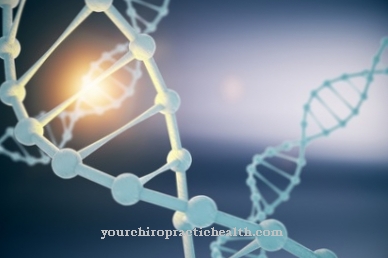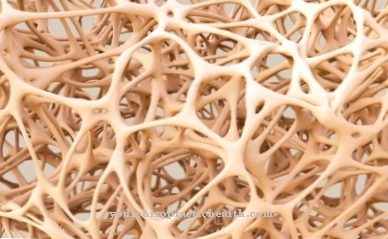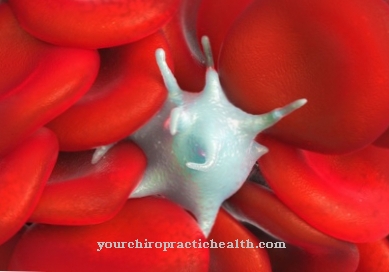Of the Sense of movement is part of the interoceptive and kinaesthetic depth sensitivity, which gives the brain permanent feedback on the extent of movements. Proprioceptors in muscles, tendons, bones and joints are responsible for the perception of movement. Neurological diseases can disrupt the sense of movement.
What about the deep sensitivity?

Human perception consists of extero and interoception. Exteroception corresponds to the perception of stimuli from the environment and determines the impressions a person gains from situations and the world. Interoception, on the other hand, means the perception of stimuli from one's own body and is a considerable part of self-perception. Surface sensitivity as a perceptual quality of the skin is, for example, an instance of exteroception.
In contrast, depth sensitivity or proprioception summarizes the human abilities to detect one's own body position in space and corresponds to an interoceptive quality of perception. Due to the deep sensitivity, the person is equipped with kinaesthesia, i.e. movement sensation. He can unconsciously control and control the movement of his body parts.
In the 19th century, the British neurologist Henry Charlton Bastian defined the sense of movement and a brain area for processing movement as kinesthesia. The sense of movement is one of three qualities of depth sensitivity and, together with the sense of position and the sense of strength or resistance, forms the entirety of the deeply sensitive perceptual instance. The sense of position gives the person information about the current body position. The sense of strength and resistance mediates the dosage between pushing and pulling and the sense of movement gives the brain continuous feedback on the extent of the movement. In this way, the sense of movement unconsciously regulates its own body position when moving. The sensory cells of the sense of movement are deeply sensitive muscle spindles, tendon spindles and receptors in the joint capsules, the ligaments and the periosteum.
Function & task
Thanks to the sense of movement, people can, for example, put their index finger to the tip of their nose with their eyes closed. He can walk, jump and run in the dark and does not have to rely on his eyesight to move.
The qualities of deeply sensitive perception are closely interlinked. The sense of movement measures the direction and speed of movements. The perception authority continuously transmits movement and position information to the brain. The force to execute the movement is measured by the sense of force and the sense of position determines the current position of the body.
The depth sensitivity not only plays closely together, but is also closely linked with the sense of balance. The receptors of deep sensitivity, and thus also of the sense of movement, are called proprioceptors. They bind to stimulus molecules and in this way register information about the tension and length of the muscles. Every skeletal muscle contains centrally located muscle spindles.
The individual muscle fibers are arranged around the muscle spindle in the shape of a spindle. The muscle ends with the tendon and the Golgi tendon organ. The tendon organ is also a sensory cell and sits on the border between muscle fibers and tendons. The muscle spindle and Golgi tendon organ provide important information on body position and body movement.
Muscle spindles are each wound with a nerve fiber that absorbs muscle tension. When a muscle contracts or starts to move, the muscle fibers rotate. The rotational movement triggers the monosynaptic twisting reflex. The nerve fibers on the muscle spindles detect the impulse and pass it on to the brain. The nerves transmit the information as an afferent reflex part to motor neurons. These movement-specialized nerve cells transmit the impulse to the cerebellum via the spinocerebellar tract and to the cerebrum via the posterior cord. Together with the joint receptors, they supply the cortex with detailed information about the position of the body. The conscious perception of this information corresponds to kinesthesia.
The sense of balance provides important additional information for balancing the body position. Its receptor cells are the hair cells and are often counted among the movement receptors.
You can find your medication here
➔ Medicines for paresthesia and circulatory disordersIllnesses & ailments
The deep sensitivity with the sense of movement as the main component is not developed to the same degree in all people. Although every person with the associated anatomical structures has at least the ability to perceive movement, the sense of movement is only expressed through movement experience. For this reason, people with a sedentary lifestyle sometimes have a less pronounced sense of movement.
This phenomenon is particularly important in the 21st century, as the modern way of life in the western world is often associated with a lack of exercise. A below-average sense of movement can be expressed, for example, in the inability to move without visual control.
Apart from the individual development of the sense of movement, complaints in the area of body sensation can also be traced back to neurological diseases. For example, polyneuropathy is a disease of the peripheral nervous system that can occur in the context of poisoning, malnutrition, infections and diabetes or alcoholism. Different nerves are damaged. In addition to surface-sensitive perceptual disorders, the disease can also lead to deep-sensitive perceptual disorders. The result is paralysis or other mobility deficits. Familiar movements are sometimes perceived as difficult when the deeply sensitive structures and nerve tracts are damaged.
The movement deficits are often associated with sensory disorders of the skin, especially in the case of a peripheral nervous disorder. Disturbances of deep sensitivity and the sense of movement are even more frequently associated with central nervous disorders. In the autoimmune disease multiple sclerosis, for example, the patient's immune system attacks nerve tissue in the central nervous system and can damage the sense of movement.
However, complaints with the sense of movement do not necessarily have to be due to illnesses, but can also be medication or alcohol and drug-related. Unlike neurological diseases or trauma, medication and alcohol or drugs only switch off deeply sensitive perception for a certain period of time.













.jpg)

.jpg)
.jpg)











.jpg)